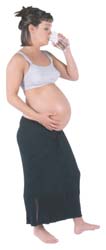Leaching BPA Plastic Chemical Linked to Aggression
and Hyperactivity in Toddlers
by www.SixWise.com
Bisphenol-A (BPA) is a chemical form of synthetic estrogen used in countless commonly used household items including water bottles, plastic food containers, food packages, canned goods and more. In all about 6 billion pounds of the chemical are produced around the world each year, amounting to $6 billion in sales.
|

New research has revealed that BPA may make infant girls more aggressive by “masculinizing” their brains.
|
The chemical, which helps harden polycarbonate plastics and epoxy resin, has been linked to serious human health conditions even at low level exposures to which Americans are commonly exposed.
“In laboratory tests, trace BPA exposure has been shown to disrupt the endocrine system and trigger a wide variety of disorders, including chromosomal and reproductive system abnormalities, impaired brain and neurological functions, cancer, cardiovascular system damage, adult-onset diabetes, early puberty, obesity and resistance to chemotherapy,” according to the Environmental Working Group (EWG).
Now, a new study has revealed another serious risk of BPA – the potential to negatively impact behavior in young children.
BPA May Alter Your Toddler’s Behavior
Exposure to BPA in utero could lead to increased aggressive behavior when those babies become toddlers. The study, the first of its kind to research the effect of BPA on children’s behavior, found that children with exposure to the highest levels of BPA before the 16th week in pregnancy had much higher scores on tests for aggression -- similar to those typically found in boys -- than girls with less exposure.
Since BPA is a synthetic form of estrogen, it’s capable of mimicking the effect of estrogen in the human body. During early pregnancy, estrogen is important in the development of the male brain, and researchers suggested that BPA might make the female brain more masculine.
"In the developing brain, timing is everything," neuropsychiatrist Louann Brizendine, author of The Female Brain, told USA Today. "I'm worried that tiny amounts of this stuff, given at just the wrong time, could partly masculinize the female brain."
Previous studies have also found more reasons to avoid BPA during pregnancy, childhood and adulthood, including:
-
Developmental problems in fetuses and infants
-
Early puberty
-
Genital deformities
-
Down’s syndrome
-
Disrupted reproductive cycles
-
Structural damage to the brain
-
Increased cancer rates in certain organs and cell lines
How are You Exposed to BPA?
BPA is common in plastic bottles (including baby bottles), but that is far from the only way you can be exposed. BPA is also widely used in:
-
Plastic gallon milk bottles
-
Plastic microwavable plates, ovenware, and utensils
-
Tooth sealants
-
Glasses
-
Food cans, soda cans, infant formula cans, etc. (as most have plastic lining in the cans)
-
Baby toys, bottles, pacifiers, and sippy cups
The problem is that BPA can leach out of these products during everyday use, contaminating your food and water and causing serious health problems.
BPA is so widely used that it may be nearly impossible to avoid exposure entirely, however you can greatly reduce your exposure by avoiding BPA-containing products as much as possible, including one of the biggest BPA predators: plastic water bottles.
 Plastic containing BPA may be called:
Plastic containing BPA may be called:
-
Polycarbonate
-
Lexan
-
Polysulfone
11 Tips to Significantly Reduce Your Exposure to BPA
BPA is so widely used, in fact, that almost everyone has the chemical in their body right now.
"Widespread and continuous exposure to BPA, primarily through food but also through drinking water, dental sealants, dermal exposure, and inhalation of household dusts, is evident from the presence of detectable levels of BPA in more than 90% of the US population" researchers wrote in the Journal of the American Medical Association.
Given the confirmed health risks of this ubiquitous chemical, even at low-level exposure, it’s important that you take steps to reduce your exposure for both yourself and your family. Fortunately, the steps are simple and easy to incorporate into your lifestyle:
 |
Superior Water from Your
New Portable Water-Filter-Bottle, Convenience with NO BPA: The Wellness H2.O
|
|
If you’re pregnant, ditch typical bottled water that may contain BPA for a safer, pure water-on-the-go solution: the Wellness H2.0!
The Wellness H2.O enhanced water bottle is the next evolution in water technology. Not content with merely replacing wasteful bottled water, the Wellness H2.O combines the best portable filtration technology with rare Japanese stones and a patented enhancement process to produce an unparalleled quality of water.
Inside the Wellness H2.O water bottle there are rare Japanese stones that enhance water's already critical role in our health and well being. Specifically, these stones give three special benefits that no other bottled or tap water can deliver:
-
Increased Hydration - Improves your body's assimilation of food,
nutrients, and vitamins and improves waste elimination
-
Free Radical Protection - Reduces free radical attack on
cells by introducing a mild antioxidant effect
-
Cellular Health - Trace alkaline minerals stabilize the water's pH,
creating an optimal environment for cells

A. Micro-filter Infused with Coconut Carbon
Reduces chlorine, chloramines, Volatile Organic Compounds (VOCs), Trihalomethanes (THMs), odor, taste, and heavy metals
B. High Gauss Magnet
Creates magnetic field which activates magnetite stone.
C. Magnetite
Increases water solubility and drops surface tension, improving hydration, nutrient assimilation and waste elimination.
D. Tenko-Seki
Ceramic generates reduced ions, adding an antioxidant effect to the water to fight free radical damage.
E. Bakuhan
Stabilizes pH and promotes an alkaline state in the body. Bakuhan is the only stone certified by the Japanese Ministry of Health as possessing natural medicinal qualities.
F. Taicho
Japanese stone inhibits the growth of harmful bacteria and fungus, while supporting healthy bacteria.
G. Quartz
Adds soluble silica to the water and polishes taste.
-
Avoid most disposable plastic water bottles. Instead, bottle your own water (in glass or BPA-free plastic) from filtered tap.
-
Buy your own Wellness H2.0, a personal reusable water bottle made of HDPE (high density polyethylene) plastic, which is BPA-free! The Wellness H2.0 features a unique filtration system that not only purifies ordinary tap water, but also enhances the water for better absorption and hydration.
-
Purchase glass baby bottles instead of plastic.
-
Buy milk and juice in glass containers (NOT plastic).
-
Use baby bottles and sippy cups made of polyethylene plastic (#1, #2, #4 recycling symbols) or polypropylene (#5) (these are usually colored, not clear)
-
Replace plastic food and drink containers and utensils with glass, ceramic or metal varieties.
-
Avoid using canned foods (as they mostly have plastic linings) or foods wrapped in plastic.
-
Avoid soda cans (as they mostly have plastic lining). If you drink soda, choose the glass bottles instead.
-
Don’t let children put plastic toys in their mouths, or give them natural fabric toys instead of plastic ones.
-
Be careful with BPA-containing plastics, if you choose to use them. This means not exposing them to heat (microwave, dishwasher) or harsh detergents (bleach, etc.), throwing them away if they're scratched or worn, and not letting food or beverages sit in the containers for too long -- all of which increases the amount of BPA that may leach into your food.
-
Dental sealant may leach BPA. Although this is being debated, you may want to avoid dental sealants on your children's baby teeth, or ask your dentist if the sealant is BPA-free.
A final route of exposure to consider is your household dust. BPA is likely found in your home's dust, and inhaling this over time could potentially lead to health problems.
To minimize dust in your home, first make sure you're using the right cleaning tools. PerfectClean, an exclusive antimicrobial line of mops, dusters, towels and more that are used by leading hospitals and other health care organizations, are the optimal choice for dusting. Rather than just pushing dust around, or worse, stirring it up into the air, PerfectClean tools are made with positively-charged ultramicrofibers that pick up everything in their path -- including dust and all of its microscopic attachments.
These ultramicrofibers are so small at an astonishing 3 microns that they're even smaller than most bacteria (each cleaning cloth contains over 300 miles of actual cleaning surface!). They pick up contaminants either used dry or dampened with water -- no harsh cleaners needed.
After you've cleaned up the dust, you can help keep your home's air cleaner, longer, using the highly recommended PIONAIR Air Treatment System. Unlike most air purifiers, the PIONAIR™ Air Treatment System doesn't wait for pollutants to contact a filter or plate. Instead, the PIONAIR generates air-purifying technology that migrates through the area and neutralizes organic odors, microbes, and molds at their source.
As a result, the PIONAIR produces fresh clean air throughout your home uniformly, by addressing the pollutant source -- without the use of fans, filters, or plates!
Again, you may not be able to avoid BPA entirely, but by taking these precautions you can ensure that you and your family are leading as pure and toxin-free a life as possible.
Recommended Reading
Why is BPA -- a Known Toxin -- Still Allowed in Your Plastic Bottles and Food Containers?
Has the FDA Failed You? BPA Still Lurking in Plastic Bottles and More
Girls Hitting Puberty at Younger & Younger Ages
Sources
Environmental Health Perspectives 2009 Dec;117(12):1945-52.
NaturalNews.com February 16, 2010
USAToday.com October 6, 2009
Journal of the American Medical Association September 16, 2008; 300(11):1303-1310
Environmental Working Group, Bisphenol-A